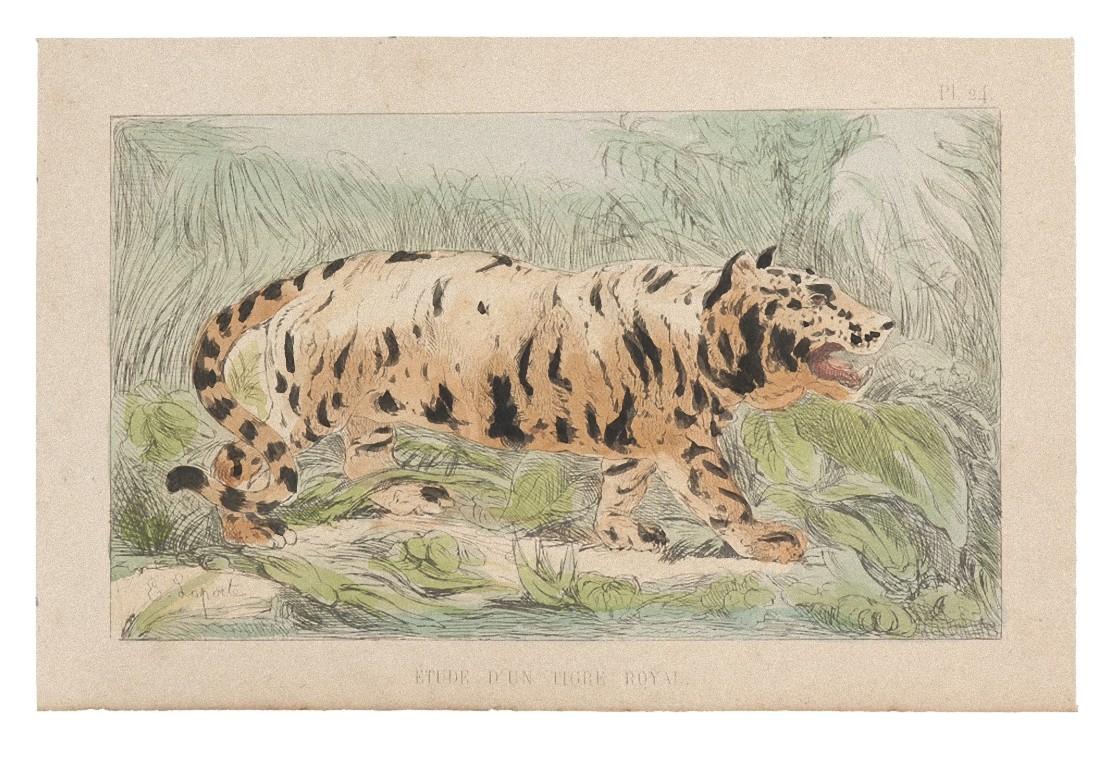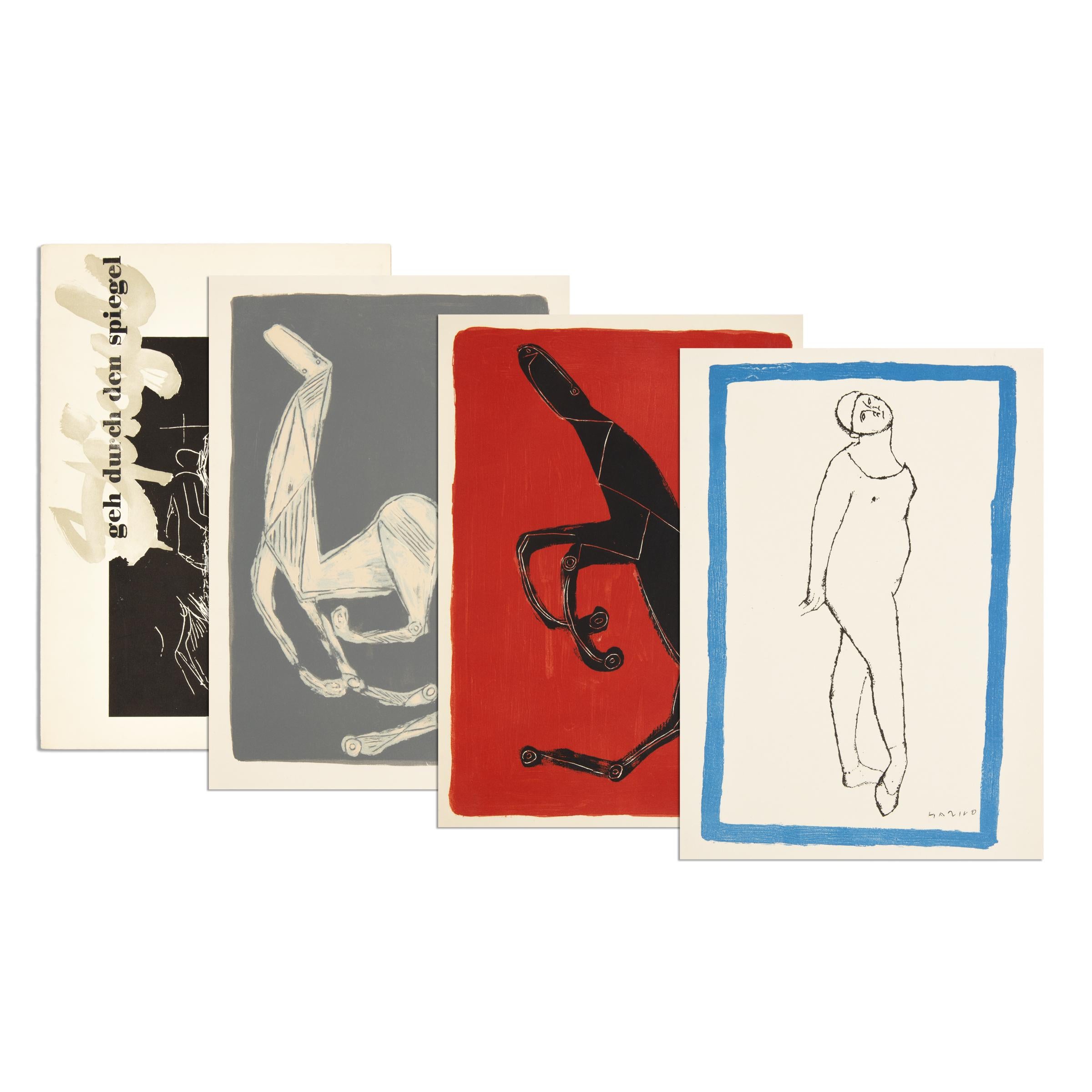Alberto GiacomettiAlberto Giacometti - Original Lithograph1964
1964
About the Item
- Creator:Alberto Giacometti (1901 - 1966, Swiss)
- Creation Year:1964
- Dimensions:Height: 14.97 in (38 cm)Width: 11.03 in (28 cm)Depth: 0.04 in (1 mm)
- Medium:
- Movement & Style:
- Period:
- Condition:
- Gallery Location:Collonge Bellerive, Geneve, CH
- Reference Number:1stDibs: LU16123559631
Alberto Giacometti
Alberto Giacometti was a painter, printmaker and furniture designer but he is best known as one of the 20th century’s most important sculptors. He is revered for the elongated, slender human figures he created in the years following World War II that reflected existentialism and the trauma associated with the conflict.
Giacometti was born in Borgonovo, Switzerland, in 1901 to a creative family. His father Giovanni was a Post-Impressionist painter, his godfather Cuno Amiet was a Fauvist painter, his brother Bruno was an architect, and his other brother Diego was an artist and furniture designer who also served as Giacometti’s model. (The sculptor worked chiefly with models plucked from his personal life.)
Beginning in 1922, Giacometti studied at the Académie de la Grande-Chaumière in Paris and was influenced by the Cubist work of Alexander Archipenko, Raymond Duchamp-Villon and the post-Cubist sculptures of Jacques Lipchitz and Henri Laurens.
During the 1930s, Giacometti designed furniture such as lamps, vases and wall décor to earn a living, often collaborating with interior designer Jean-Michel Frank, whose interiors tastefully mixed extravagance with sophisticated simplicity. However, Giacometti’s passion lay in creating sculptures.
Alberto and his brother Diego left Paris in 1940 to escape the Nazi invasion and spent time in the South of France before fleeing to Geneva, remaining there until 1946. In 1947, Giacometti began work on his most famous sculptures — very tall and thin figurines that came to be associated with frailty and loneliness.
Giacometti catapulted to fame in the United States following two exhibitions of his sculptures in 1948 and 1950 at the Pierre Matisse Gallery in New York City — Jean-Paul Sartre authored the catalogue essay for the latter. In 1961, Giacometti’s friend, Irish playwright Samuel Beckett, asked him to design the set for a re-staging of his play “Waiting for Godot.” His response took on the form of a single plaster tree.
In 1962, Giacometti won the grand prize for sculpture at the Venice Biennale, and for much of the rest of his career, he created modern paintings, drawings and sculptures of plaster, clay and bronze in his small Paris studio. He died in 1966.
Giacometti’s works continue to enthrall collectors. In 2010, his life-size bronze sculpture L'Homme qui marche (“the man who walks”), which now adorns the 100 Swiss Franc banknote, became one of the most expensive sculptures to be sold at auction.
On 1stDibs, discover a range of vintage Alberto Giacometti wall decorations, prints and sculptures.
- ShippingRetrieving quote...Ships From: Collonge Bellerive, Geneve, Switzerland
- Return PolicyA return for this item may be initiated within 7 days of delivery.
- The Human Comedy - LithographBy (after) Pablo PicassoLocated in Collonge Bellerive, Geneve, CHAfter Pablo Picasso The Human Comedy - Lithograph after an original drawing, as published in the journal "Verve" Printed signature and date Dimensions...Category
1950s Modern Animal Prints
MaterialsLithograph
- The Human Comedy - LithographBy (after) Pablo PicassoLocated in Collonge Bellerive, Geneve, CHAfter Pablo Picasso The Human Comedy - Lithograph after an original drawing, as published in the journal "Verve" Printed signature and date Dimensi...Category
1950s Modern Figurative Prints
MaterialsLithograph
- Enrico Baj - LithographBy Enrico BajLocated in Collonge Bellerive, Geneve, CHEnrico Baj - Original Lithograph Colorful Abstraction 1962 From the art revue XXe Siecle Dimensions: 32 x 24 Edition: G. di San Lazzaro. Unsigned and unumbered as issuedCategory
1960s Modern Figurative Prints
MaterialsLithograph
- Max Ernst - The Soldier - Original LithographBy Max ErnstLocated in Collonge Bellerive, Geneve, CHMax Ernst (1891-1976) Georges Ribemont-Dessaignes, La Ballade du Soldat, Pierre Chave, Vence, 1972 Colour lithographs on Arches paper 1972 Edition : 199 Dimensions: 40 x 30 cm Refe...Category
1970s Modern Figurative Prints
MaterialsLithograph
- Max Ernst - The Soldier - Original LithographBy Max ErnstLocated in Collonge Bellerive, Geneve, CHMax Ernst (1891-1976) Georges Ribemont-Dessaignes, La Ballade du Soldat, Pierre Chave, Vence, 1972 Colour lithographs on Arches paper 1972 Edition : 199 Dimensions: 40 x 30 cm Refe...Category
1970s Modern Figurative Prints
MaterialsLithograph
- Pablo Picasso - La Petite Corrida - Original LithographBy Pablo PicassoLocated in Collonge Bellerive, Geneve, CHPablo Picasso - Original Lithograph La Petite Corrida (The Small Bullfight) 1958 Edition of 2000, unsigned Published in the journal XXe Siecle Dimens...Category
1950s Modern Figurative Prints
MaterialsLithograph
- The Tiger - Original Lithograph by Emile Henri Laporte - 1860By Emile Henri LaporteLocated in Roma, ITThe Tiger is an original modern artwork realized in 1860 by the French artist Emile Henri Laporte (1841 - 1919). Original colored Lithograph on paper. Han...Category
1970s Modern Figurative Prints
MaterialsLithograph
- Marino Marini, Geh durch den Spiegel: Catalogue including 3 Original LithographsBy Marino MariniLocated in Hamburg, DEMarino Marini (Italian, 1901-1980) Geh durch den Spiegel 1, 1954 Catalogue including 3 lithographs on paper (loose, mounted) 38 x 26 cm Markings: Each sheet signed in plateCategory
Mid-20th Century Modern Figurative Prints
MaterialsLithograph
- "Présure Guillien, Dijon Cow, " Original Color Lithograph Poster by L. SerreLocated in Milwaukee, WI"Présure Guillien, Dijon Cow" is an original color lithograph poster. The artist's name is printed in the lower left, and the name of the printing company, Havas, is printed in the lower right. The poster advertises rennet, a product used to curdle milk and make cheese, featuring a milk maid with a red kerchief tied around her head in front of a white cow. She holds a golden bucket...Category
1920s Modern Figurative Prints
MaterialsLithograph
- Etude pour l'Homme au MoutonBy Pablo PicassoLocated in Long Island City, NYLithograph created by Daniel Jacomet based on the drawing of March 30, 1943, belonging to the portfolio La Flute Double Artist: Pablo Picasso (after), Spa...Category
1960s Modern Figurative Prints
MaterialsLithograph
- Good Night Darling Mouses - Original Lithograph by J.J. Grandville - 1852Located in Roma, ITGood Night Darling Mouses is an original lithographs on ivory-colored paper realized by J.J. Grandville from Scènes de la vie privée et publique des animaux, 1852. Published by Manes...Category
1850s Modern Figurative Prints
MaterialsLithograph
- Bareback Act, Old HippodromeBy Gifford BealLocated in Missouri, MOBareback Act, Old Hippodrome By Gifford Beal (1879-1956) Signed Lower Right Unframed: 6.5" x 9.5" Framed: 17.5" x 20" Gifford Beal, painter, etcher, muralist, and teacher, was born in New York City in 1879. The son of landscape painter William Reynolds Beal, Gifford Beal began studying at William Merritt Chase's Shinnecock School of Art (the first established school of plein air painting in America) at the age of thirteen, when he accompanied his older brother, Reynolds, to summer classes. He remained a pupil of Chase's for ten years also studying with him in New York City at the artist's private studio in the Tenth Street Studio Building. Later at his father's behest, he attended Princeton University from 1896 to 1900 while still continuing his lessons with Chase. Upon graduation from Princeton he took classes at the Art Students' League, studying with impressionist landscape painter Henry Ward Ranger and Boston academic painter Frank Vincent DuMond. He ended up as President of the Art Students League for fourteen years, "a distinction unsurpassed by any other artist." His student days were spent entirely in this country. "Given the opportunity to visit Paris en route to England in 1908, he chose to avoid it" he stated, "I didn't trust myself with the delightful life in ParisIt all sounded so fascinating and easy and loose." His subjects were predominately American, and it has been said stylistically "his art is completely American." Gifford achieved early recognition in the New York Art World. He became an associate member of the National Academy of Design in 1908 and was elected to full status of academician in 1914. He was known for garden parties, circuses, landscapes, streets, coasts, flowers and marines. This diversity in subject matter created "no typical or characteristic style to his work." Beal's style was highly influenced by Chase and Childe Hassam, a long time friend of the Beal family who used to travel "about the countryside with Beal in a car sketching...Category
20th Century American Modern Animal Prints
MaterialsLithograph






